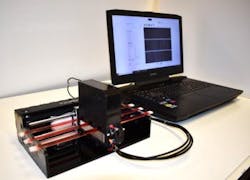Lensless imaging device boosts speed, sensitivity in detecting parasitic infections
Recognizing the need for a faster, cheaper method to detect parasitic infections in resource-poor areas, a team of researchers at the University of California Los Angeles (UCLA) Henry Samueli School of Engineering has developed a low-cost mobile platform that harnesses lensless imaging to rapidly detect motile parasites in bodily fluids automatically. Using their platform, more than 3 mL of a bodily fluid sample can be imaged and analyzed within 20 minutes, providing a throughput that is orders of magnitude better than traditional optical microscopy-based examination.
The research was led by Aydogan Ozcan, Chancellor's Professor of Electrical and Computer Engineering at UCLA and the associate director of the California NanoSystems Institute at UCLA, along with Kent Hill, a Professor in the Department of Microbiology, Immunology, and Molecular Genetics at UCLA.
Instead of directly capturing a still image of the fluid sample and searching for parasites, this platform takes a different approach and detects motion within the sample. It records high-frame-rate videos of the holographic patterns of the sample illuminated with laser light. Then, a motion analysis algorithm analyzes these captured videos at the microscale and converts the locomotion of the target parasites within the sample into a signal spot, which is detected and counted using artificial intelligence (AI).
"Although motility is a common feature of various parasites and other disease-causing microorganisms, its use as a fingerprint for diagnosis is highly underexplored and our work provides landmark results, highlighting this unique opportunity," Ozcan says.
"Our platform can be considered as a motion detector in the microscopic world, which locks onto any moving objects within the sample," says Yibo Zhang, a UCLA doctoral student and the first author of the paper that describes the work. "Locomotion is used as both a biomarker and a contrast mechanism to distinguish parasites from normal cells."
The high-throughput bodily fluid screening device, which screens and analyzes ~3.2 mL of fluid sample within ~20 min. (Photo credit: Y. Zhang et al., Light Sci. Appl.; doi:10.1038/s41377-018-0110-1)
The proof of concept of this device has been demonstrated using Trypanosoma parasites, which have multiple subspecies that cause sleeping sickness and Chagas disease. The detection limit of the device was quantified as 10 parasites per milliliter of whole blood, which is about 5X better than the state-of-the-art parasitological detection methods. This improved detection limit may lead to a better capability to detect sleeping sickness and Chagas disease at an earlier stage, which is essential to improve the cure rate and reduce its prevalence. Beyond trypanosomes, the authors also demonstrated the use of their device to detect Trichomonas vaginalis, highlighting that their technique is applicable to various parasites and motile microorganisms.
The device weighs only 1.69 kg and the cost of the prototype is <$1850, which can be reduced to <$800 when manufactured in larger volumes.
Full details of the work appear in the journal Light: Science & Applications.
